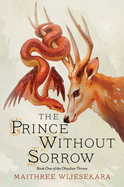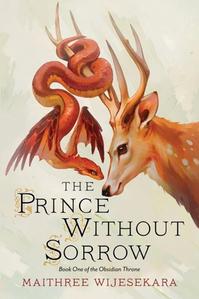
 In Maithree Wijesekara's The Prince Without Sorrow, the mayakari--witches--of the Ran Empire emit blue and white flames when burned. The mayakari might have power that the rest of the Ran Empire does not understand, but their code requires that they always use it to uphold peace. That does not stop Emperor Adil Maurya from viciously hunting the mayakari, blaming them for everything that goes wrong in the empire, and even burn-testing suspected women to ensure that they are not a threat. Learning about them, their history, and their ways is forbidden, with libraries burned alongside the women targeted by the Empire.
In Maithree Wijesekara's The Prince Without Sorrow, the mayakari--witches--of the Ran Empire emit blue and white flames when burned. The mayakari might have power that the rest of the Ran Empire does not understand, but their code requires that they always use it to uphold peace. That does not stop Emperor Adil Maurya from viciously hunting the mayakari, blaming them for everything that goes wrong in the empire, and even burn-testing suspected women to ensure that they are not a threat. Learning about them, their history, and their ways is forbidden, with libraries burned alongside the women targeted by the Empire.
The emperor's youngest son, Ashoka, does not agree with either Adil's persecution of the mayakari nor his thirst for conquest, but Adil spurns his son's push for pacifism, instead choosing violence. But he won't be the only one to make that choice. When Adil brings the full force of the Ran Empire to bear on the mayakari of Shakti's village, burning them all, including her aunt, Shakti's need for vengeance is born in the blue flames of her aunt's body. The curse she casts in response will have devastating consequences for the Emperor, his children, and the whole Ran Empire.
Drawing influences from the Maurya Empire of Ancient India and loose inspiration from Emperor Ashoka the Great, this first volume in a projected trilogy explores questions of good and evil, and what it means to do harm on individual and institutional levels. On her website, Wijesekara notes that Ashoka the Great was known as both Dharmashoka (Ashoka the Pious) and Chandashoka (Ashoka the Cruel); that extreme difference in epithets was a point of fascination for her that helped to solidify the idea for The Prince Without Sorrow.
The world of The Prince Without Sorrow is populated not only by the mayakari, but also by giant leopards and winged snakes that can be ridden, and by nature spirits that can either help the human world or damage it greatly, especially if in response to nature being exploited. The tensions between violence and pacifism--and between causing no harm but also preventing harm to those who are vulnerable--put pressure and strain on the relationships between the characters as the narrative alternates between Shakti's and Ashoka's points of view. How both are forever changed by the events spurred by Emperor Adil, and where their paths through peace and violence will lead them, promise readers a fast-paced ride full of murder, retribution, and the search for justice, right up to the novel's final cliffhanger. --Michelle Anya Anjirbag, freelance reviewer
Shelf Talker: Wijesekara's thrilling, imaginative debut novel will leave readers clamoring for the rest of the trilogy while savoring the fascinating worldbuilding and complex characters they meet in The Prince Without Sorrow.

